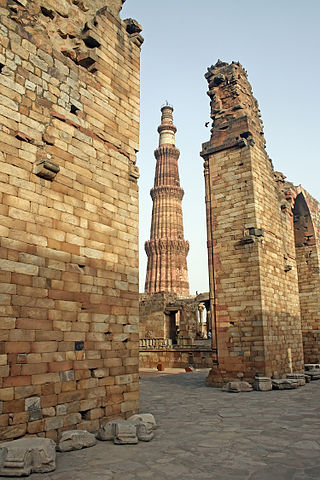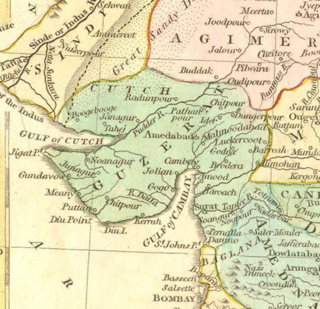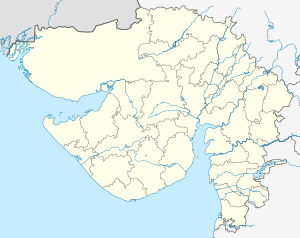
Mirza Shahab-ud-Din Muhammad Khurram, commonly called Shah Jahan I, also called Shah Jahan the Magnificent, was Emperor of Hindustan from 1628 until his deposition in 1658. As the fifth Mughal emperor, his reign marked the zenith of Mughal architectural and cultural achievements.

The Chishti order is a Sufi order of Sunni Islam named after the town of Chisht, Afghanistan where it was initiated by Abu Ishaq Shami. The order was brought to Herat and later spread across South Asia by Mu'in al-Din Chishti in the city of Ajmer.

The Muslim period in the Indian subcontinent or Indo-Muslim period is conventionally said to have started in 712, after the conquest of Sindh and Multan by the Umayyad Caliphate under the military command of Muhammad ibn al-Qasim. It began in the Indian subcontinent in the course of a gradual conquest. The perfunctory rule by the Ghaznavids in Punjab was followed by Ghurids, and Sultan Muhammad of Ghor is generally credited with laying the foundation of Muslim rule in Northern India.

The Qutb Minar complex are monuments and buildings from the Delhi Sultanate at Mehrauli in Delhi, India. Construction of the Qutub Minar "victory tower" in the complex, named after the religious figure Sufi Saint Khwaja Qutbuddin Bakhtiar Kaki, was begun by Qutb-ud-din Aibak, who later became the first Sultan of Delhi of the Mamluk dynasty. It was continued by his successor Iltutmish, and finally completed much later by Firoz Shah Tughlaq, a Sultan of Delhi from the Tughlaq dynasty (1320–1412) in 1368 AD. The Qubbat-ul-Islam Mosque, later corrupted into Quwwat-ul Islam, stands next to the Qutb Minar.
The Muzaffarid dynasty, also called the Muzaffarids, and sometimes, the Ahmedabad dynasty, ruled the Sultanate of Gujarat in western India from 1391 to 1583. The founder of the dynasty was Zafar Khan who was governor of Gujarat under the Delhi Sultanate. When the Sultanate was weakened by the sacking of Delhi by Timur in 1398, and Zafar Khan took the opportunity to establish himself as sultan of an independent Gujarat. His Grand son, Ahmed Shah I established the capital at Ahmedabad. The dynasty ruled for almost 200 years, until the conquest of Gujarat by the Mughal Empire in 1572. The sultanate reached its peak of expansion under Mahmud Begada, reaching east into Malwa and west to the Gulf of Kutch.

Indo-Islamic architecture is the architecture of the Indian subcontinent produced by and for Islamic patrons and purposes. Despite an initial Arab presence in Sindh, the development of Indo-Islamic architecture began in earnest with the establishment of Delhi as the capital of the Ghurid dynasty in 1193. Succeeding the Ghurids was the Delhi Sultanate, a series of Central Asian dynasties that consolidated much of North, East, and Central India, and later by the Mughal Empire during the early 16th century. Both of these dynasties introduced Islamic architecture and art styles from West Asia into the Indian subcontinent.

Sheikh Salim Chishti also known as Sheikh al- Hind was a Sufi saint of the Chishti Order and one of the most revered Sufi saints during the Mughal Empire in India.

The Gujarat Sultanate or Sultanate of Guzerat was a late medieval Islamic Indian kingdom in Western India, primarily in the present-day state of Gujarat. The kingdom was established in 1394 when Muzaffar Shah I, the Governor of Gujarat, declared independence from the Tughlaq dynasty of Delhi.

Amir Kulāl (1278–1370), Persian: امیر کلال, Arabic: امیر کلال, birth name Shams ud-Dīn, was a Persian Sufi Islamic scholar, widely considered to be one of the most influential in history. He was a member of the mystical Khajagan order. His father was the Sufi scholar Saif ud-Dīn Hamza, a sayyid descendant of Muhammad. Saif ud-Dīn Hamza was amir (chieftain) of the Persian Kulal-Tribe, his full title being Amir-i-Kulal. After his father's death, Shams ud-Dīn became the amir and head of the tribe. By this time his reputation as a scholar and religious figure had spread through Chagatai Khanate and the title Amir-i-Kulal, had become his common name. Because he made earthenware, he was popularly referred to as “Kulāl”, which means "potter" in Persian.

Sufism has a history in India that has been evolving for over 1,000 years. The presence of Sufism has been a leading entity increasing the reaches of Islam throughout South Asia. Following the entrance of Islam in the early 8th century, Sufi mystic traditions became more visible during the 10th and 11th centuries of the Delhi Sultanate and after it to the rest of India. A conglomeration of four chronologically separate dynasties, the early Delhi Sultanate consisted of rulers from Turkic and Afghan lands. This Persian influence flooded South Asia with Islam, Sufi thought, syncretic values, literature, education, and entertainment that has created an enduring impact on the presence of Islam in India today. Sufi preachers, merchants and missionaries also settled in coastal Gujarat through maritime voyages and trade.

Chausath Khamba, also spelled Chaunsath Khamba, is a tomb built during 1623–24. It is located in Nizamuddin precincts of Sufi Muslim shrines and tombs in New Delhi, India. The name means "64 pillars" in Urdu and Hindi. It was built by Mirza Aziz Koka, son of Ataga Khan, as a mausoleum for himself, at the time when Mughal Emperor Jahangir ruled from Delhi. Mirza Aziz Koka had served several times as Jahangir’s Governor of Gujarat before he died in Gujarat.

The Shattari or Shattariyya are members of a Sufi order that originated in Safavid Iran in the fifteenth century and developed, completed, and codified in India. Later, secondary branches were taken to the Hejaz and to Indonesia. The word Shattar, which means "lightning-quick," "speed," "rapidity," or "fast-goer" shows a system of spiritual practices that lead to a state of "completion," but the name derives from its founder, Abdullah Shattar.

The Sarkhej Roza is a Sufi mosque and tomb complex located in the village of Makarba, 7 kilometres (4.3 mi) south-west of Ahmedabad in Gujarat state, India.

Mirza Aziz Koka, also known as Kokaltash and by his sobriquet Khan-i-Azam, was the foster brother of Akbar, who remained one of the leading nobles at the courts of the Mughal emperors Akbar and Jahangir. He was also the Subahdar, governor of the Subah (province) of Gujarat.

Shah Wajihuddin Alvi Gujarati, also known the epithet Haider Ali Saani, was an Islamic scholar and Sufi in the Shattari order.

Muzaffar Shah I, born Zafar Khan, was the founder of the Muzaffarid dynasty in Medieval India, reigning over the Gujarat Sultanate from 1391 to 1403 and again from 1404 to 1411.

The Gujarat Subah was a province (subah) of the Mughal Empire, encompassing the Gujarat region. The region first fell under Mughal control in 1573, when the Mughal emperor Akbar defeated the Gujarat Sultanate under Muzaffar Shah III.

The Khanqah and Mausoleum of Sultan Barsbay or Complex of Sultan Barsbay is an Islamic funerary complex built by Sultan al-Ashraf Barsbay in 1432 CE in the historic Northern Cemetery of Cairo, Egypt. In addition to its overall layout and decoration, it is notable for the first stone domes in Cairo to be carved with geometric star patterns.

Shaikh Farid Bukhari, also known by the title Murtaza Khan, was a leading Mughal noble of the 17th century. He served as mir bakhshi of the empire during the reign of the Mughal emperor Akbar. During the reign of Akbar's successor Jahangir, he played a key role in the suppression of prince Khusrau's rebellion, and later governed the provinces of Gujarat and Punjab. He was also well known as an architectural patron in Mughal India, and founded the city of Faridabad in modern-day Haryana, India.





















